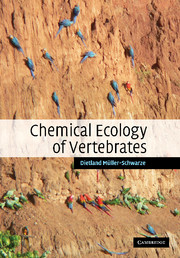Book contents
- Frontmatter
- Contents
- Preface
- Acknowledgements
- 1 The odorsphere: the environment for transmission of chemical signals
- 2 Properties of vertebrate semiochemicals
- 3 Odor production and release
- 4 Chemical cues in orientation and navigation
- 5 Chemoreception
- 6 Signaling pheromones I: discrimination and recognition
- 7 Signaling pheromones II: sex and alarm pheromones and evolutionary considerations
- 8 Intraspecific signals: priming pheromones
- 9 Development of intra- and interspecific chemical communication
- 10 Allomones I: chemical defense by animals
- 11 Allomones II: plant chemical defenses against herbivores
- 12 Kairomones and synomones
- 13 Practical applications of semiochemicals
- Glosssary
- References
- Index
13 - Practical applications of semiochemicals
Published online by Cambridge University Press: 23 November 2009
- Frontmatter
- Contents
- Preface
- Acknowledgements
- 1 The odorsphere: the environment for transmission of chemical signals
- 2 Properties of vertebrate semiochemicals
- 3 Odor production and release
- 4 Chemical cues in orientation and navigation
- 5 Chemoreception
- 6 Signaling pheromones I: discrimination and recognition
- 7 Signaling pheromones II: sex and alarm pheromones and evolutionary considerations
- 8 Intraspecific signals: priming pheromones
- 9 Development of intra- and interspecific chemical communication
- 10 Allomones I: chemical defense by animals
- 11 Allomones II: plant chemical defenses against herbivores
- 12 Kairomones and synomones
- 13 Practical applications of semiochemicals
- Glosssary
- References
- Index
Summary
Give me an ounce of civet,
good apothecary,
to sweeten my imagination
shakespeare: King Lear Act IV, sc. 6, 1.132Smelly secretions as repellents: “The devil can be completely undone if you manage to fart into his nostrils.” (beating the devil with his own weapons).
martin luther (Erik Erikson: Young Man Luther, p. 61–62)Chemical cues hold considerable promise for manipulating behavior in vertebrates, provided we understand an animal's natural history, biology, and behavior well. However, the development of chemical attractants, stimulants, inhibitors, and repellents for vertebrates has progressed rather slowly for several reasons. First, chemical stimulus and behavior are not connected as rigidly as in insects, for example. Second, the same stimulus may elicit different behaviors, depending on the state of the recipient and the context. Third, chemical cues often are rather complex mixtures of compounds. Fourth, learning, especially early experience plays a major role in vertebrate, notably mammalian behavior. Finally, many behaviors are modulated by several sensory modalities so that chemical stimuli alone trigger only incomplete responses at best.
Fish
The desire for improved techniques in fishing, aquaculture, and limnological management motivates much of the current basic work in the chemical ecology of fish.
Chemical imprinting
Hatcheries raise fish and release them in lakes and rivers on a large scale. Some species such as salmon imprint early in life on the odor of their home stream. Cohosalmon imprint when just over a year old (smolt stage), and sockeye salmon even earlier, right after hatching. Coho salmon prepare to migrate from rivers to the ocean as smolt. Proper imprinting ensures their return as adults to the home stream in order to spawn.
- Type
- Chapter
- Information
- Chemical Ecology of Vertebrates , pp. 391 - 422Publisher: Cambridge University PressPrint publication year: 2006



